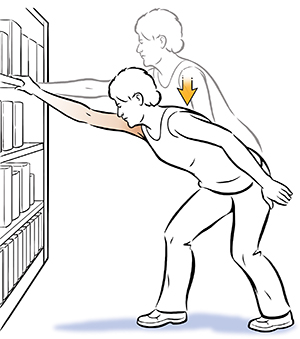"Reaching Up" for Shoulder Flexibility
This stretch can help restore shoulder flexibility and relieve pain over time. When stretching, be sure to breathe deeply. And follow any special instructions from your healthcare provider or therapist.
-
Raise the hand on the side you want to stretch as high as you can. Then grasp a stable and sturdy surface, such as a bookcase or a door frame, with the same hand.
-
Keeping your arm straight, lower your body by bending your knees. Stop when you feel the stretch in the shoulder. Try to hold the stretch for 5 seconds.
-
Work up to doing 3 sets of this stretch, 3 times a day. Work up to holding the stretch for 30 to 60 seconds.
Note: Your back should remain straight. To enhance the stretch over time, try to bend your knees lower. Or raise your arm higher at the start of the stretch.

Frozen shoulder
Frozen shoulder is another name for adhesive capsulitis. This causes restricted movement in the shoulder. If you have frozen shoulder, this stretch may cause mild pain, especially when you first get started. A few months may pass before you get the results you want. But once your shoulder heals, it rarely becomes frozen again. So stick to your stretching program. If you have any questions, ask your healthcare provider.